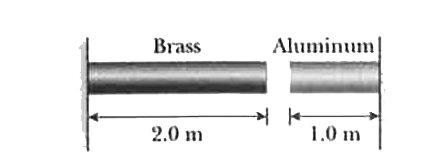The brass bar and the alumiumn bar in the drawing are each attached to an immovable wall. At 28∘C the air gap between the rods is 1.3×10−3 m . At what temperature will the be closed ?

The correct Answer is:D
Step by step video & image solution for The brass bar and the alumiumn bar in the drawing are each attached to an immovable wall. At 28^@C the air gap between the rods is 1.3xx10^(-3) m . At what temperature will the be closed ? by Physics experts to help you in doubts & scoring excellent marks in Class 12 exams.
Topper's Solved these Questions
- BOOK - RESNICK AND HALLIDAYCHAPTER - TEMPERATURE, ZEROTH LAW OF THERMODYNAMICS AND THERMAL EXPANSION EXERCISE - PRACTICE QUETIONS (Matrix- Match )3videos
TEMPERATURE, ZEROTH LAW OF THERMODYNAMICS AND THERMAL EXPANSION
- BOOK - RESNICK AND HALLIDAYCHAPTER - RIGID BODY DYNAMICS-IIEXERCISE - PRACTICE QUESTIONS (Integer Type)2videos
RIGID BODY DYNAMICS-II
- BOOK - RESNICK AND HALLIDAYCHAPTER - THE FIRST LAW OF THERMODYNAMICSEXERCISE - PRACTICE QUESTIONS ( INTEGER TYPE )3videos
THE FIRST LAW OF THERMODYNAMICS
Similar Questions
Gaps are left while laying the railway lines in order to allow for expansion. The gap between steel rails of length 65 m is 3.56 cm at 15∘C . Calculate the temperature at which the rails will just touch each other. Take, Osteel=1.1×10−5∘C−1
View SolutionA brass rod is 69.5 cm long and an aluminum rod is 49.0 cm long when both rods are at an initial temperature of 0∘C. The rods are placed in line with a gap of 1.5mm between them. The distance between the far ends of the rods remains same throughout. the temperapure is raised until the two rods are barely in contact. The coefficients of linear expansion of brass and aluminum are 2.0×10−5K−1 and 2.4×10−5K−1 respectively. In figure, the temperature at which contact of the rods barely occurs, in .∘C is closest to:
zView Solution
Knowledge Check
- Question 1 - Select One
If at temperature T1=1000K the wavelength is 1.4×10−6m then at what temperature the wavelength will be m 2.8×10−6m
A2000 KB500 KC250 KDNone of these - Question 2 - Select One
The figure shows two thin rods , one made of aluminium [α=23×10−6(C∘)−1] and the other of steel [α=12×10−6(C∘)−1]. Each rod has the same length and the same initial temperature . They are attached at one end to two separate immovable walls. Temperature of both the rods is increased by the same amount , until the gap between the rods vanishes . Where do the rods meet the gap vanishes?
_S01_077_Q01.png) AThe rods meet exactly at the midpoint.BThe rods meet to the right of the midpoint.CThe rods meet to the left of the midpoint .DInformation insufficient
AThe rods meet exactly at the midpoint.BThe rods meet to the right of the midpoint.CThe rods meet to the left of the midpoint .DInformation insufficient - Question 3 - Select One
One end of a brass bar is maintained at 306∘C, while the other end is kept at a constant, but lower, temperature. The cross-sectional area of the bar is 2.6×10−4m2. Because of insulation, there is negligible heat loss through the sides of the bar . Heat flows through the bar, however, at the rate 3.6 J / s . What is the temperature of the bar at a point 0.15m from the hot end ?
A301∘CB297∘CC287∘CD265∘C
A steel rod is 3 cm in diameter at −10.00∘C . A brass ring has an interior diameter of 2.992 cm at −10.00∘C . At what common temperature will the ring just slide onto the rod ?
View SolutionTwo rods of equal cross sections, one of copper and the other of steel, are joined to form a composite rod of length 2.0 m at 20∘C, the length of the copper rod is 0.5 m. When the temperature is raised to 120∘C, the length of composite rod increases to 2.002m. If the composite rod is fixed between two rigid walls and thus not allowed to expand, it is found that the lengths of the component rods also do not change with increase in temperature. Calculate Young's modulus of steel. (The coefficient of linear expansion of copper, αc=1.6×10−5∘C and Young's modulus of copper is 1.3×1013N/m2).
View SolutionA brass rod of length 50 cm and diameter 3.0 mm is joined to a steel rod of the same length and diameter. What is the change in length of the combined rod at 250∘C, if the original lengths are at 40.0∘C? Is there a 'thermal stress' developed at the junction ? The ends of the rod are free to expand. Coefficient of linear expansion of brass =2.0×10−5.∘C−1 and that of steel =1.2×10−5.∘C−1.
View SolutionA bar of copper of length 75 cm and a bar of steel of length 125 cm are joined together end to end . Both are of circular cross - section with diameter 2 cm . The free ends of the copper and steel bars are maintained at 100∘C and 0∘C respectively . The surface of the bars are thermally insulted . What is the temperature of the copper - steel junction ? What is the heat transmitted per unit time across the junction ? Thermal conductivty of copper 9.2×10−2kcalm−1∘C−1s−1 and that of steel is 1.1×10−2kcalm−1s−1(∘)C−1.
View SolutionA bubble of air is underwater at temperature 15∘C and the pressure 1.5 bar. If the bubble rises to the surface where the temperature is 25∘C and the pressure is 1.0 bar, what will happen to the volume of the bubble?
View Solution

